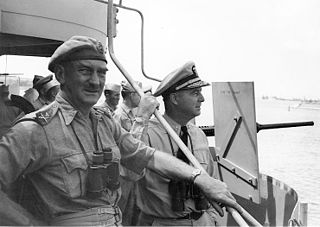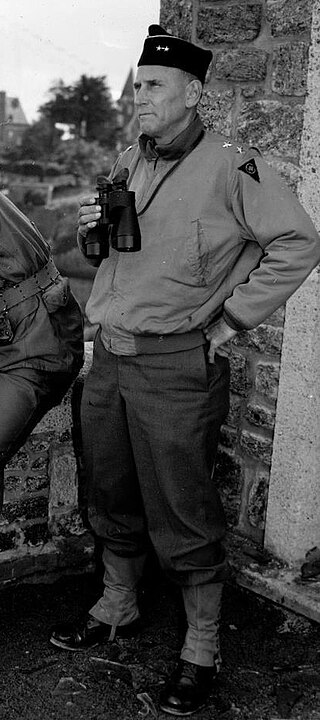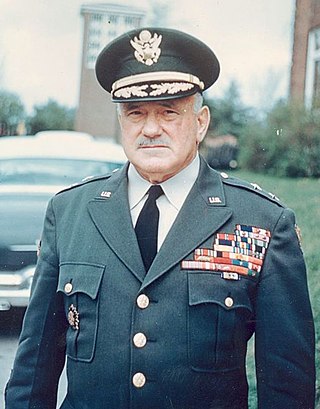Related Research Articles

Free France was a political entity that claimed to be the legitimate government of France following the dissolution of the Third Republic. Led by General Charles de Gaulle, Free France was established as a government-in-exile in London in June 1940 after the Fall of France during World War II and fought the Axis as an Allied nation with its Free French Forces. Free France also supported the resistance in Nazi-occupied France, known as the French Forces of the Interior, as well as gained strategic footholds in several French colonies in Africa.

The First Army was a field army of France that fought during World War I and World War II. It was also active during the Cold War.

Leonard Townsend Gerow was a general in the United States Army who served with distinction in both World War I and World War II.

General Sir Kenneth Arthur Noel Anderson, was a senior British Army officer who saw service in both world wars. He is mainly remembered as the commander of the British First Army during Operation Torch, the Allied invasion of North Africa and the subsequent Tunisian campaign which ended with the capture of almost 250,000 Axis soldiers. An outwardly reserved character, he did not court popularity either with his superiors or with the public.

The 78th Infantry Division, also known as the Battleaxe Division, was an infantry division of the British Army, raised during the Second World War that fought, with great distinction, in Tunisia, Sicily and Italy from late 1942–1945.

The Allied leaders of World War II listed below comprise the important political and military figures who fought for or supported the Allies during World War II. Engaged in total war, they had to adapt to new types of modern warfare, on the military, psychological and economic fronts.

The Axis leaders of World War II were important political and military figures during World War II. The Axis was established with the signing of the Tripartite Pact in 1940 and pursued a strongly militarist and nationalist ideology; with a policy of anti-communism. During the early phase of the war, puppet governments were established in their occupied nations. When the war ended, many of them faced trial for war crimes. The chief leaders were Adolf Hitler of Nazi Germany, Benito Mussolini of Fascist Italy, and Hirohito of Imperial Japan. Unlike what happened with the Allies, there was never a joint meeting of the main Axis heads of government, although Mussolini and Hitler met on a regular basis.
The 1st Army Corps was first formed before World War I. During World War II it fought in the Campaign for France in 1940, on the Mediterranean islands of Corsica and Elba in 1943 - 1944 and in the campaigns to liberate France in 1944 and invade Germany in 1945.
The 19th Army Corps was a corps of the French army. In December 1870, the Tours delegation created the 19th Army Corps which was formed in Alençon. It was recreated by decree of the JO of August 13, 1874, it brought together the various military units of Algeria. It constituted the nucleus of the Army of Africa.
The 2nd Army Corps was first formed before World War I. During World War II it fought in the Campaign for France in 1940 and during the 1944–45 campaigns in southern France, the Vosges Mountains, Alsace, and southwestern Germany. It was active under the First Army for many years after World War II.

Lieutenant-General Sir John Ledlie Inglis Hawkesworth, was a senior British Army officer who served during both World Wars. During the Second World War he commanded the 4th Division during the Tunisian Campaign in early 1943, later commanding the 46th Division throughout most of the Italian Campaign and, finally, X Corps in Greece, before suffering from a fatal heart attack in June 1945.

Major General Robert Chauncey Macon was a senior United States Army officer who commanded the 7th Infantry Regiment and the 83rd Infantry Division during World War II in Western Europe and later served as military attaché in Moscow.

Major General Ernest Nason Harmon was a senior officer of the United States Army. He served in both World War I and World War II, and is best known for his actions in reorganizing the 1st Armored Division after the debacle in February 1943 at the Battle of Kasserine Pass during the Tunisian campaign.
Jacques Marie Alfred Gaston Faure was a French Army general and skier. He was the leader of the French national Olympic military patrol team in 1936 which placed sixth and in 1961 one of the masterminds of the Algiers putsch.

General Sir George Watkin Eben James Erskine was a British Army officer from Hascombe, Surrey. After he graduated from Royal Military College, Sandhurst, Erskine enlisted in the King's Royal Rifle Corps and saw action on the Western Front of World War I. During World War II, he commanded the 7th Armoured Division from 1943 to 1944. After World War II, Erksine commanded counterinsurgency operations against the Kenya Land and Freedom Army (KLFA) during the Mau Mau rebellion.
Raymond Francis Duval was a French general who participated in both World War I and World War II and was supreme commander of French troops in Tunisia and French Morocco. During his career, he brutally suppressed the insurrection at Setif, Algeria in May 1945, resulting in the massacre of 6,000 to 30,000 people.

The Seventh Army was a United States army created during World War II that evolved into the United States Army Europe (USAREUR) during the 1950s and 1960s. It served in North Africa and Italy in the Mediterranean Theater of Operations and France and Germany in the European Theater between 1942 and 1945.

Major General Fred Livingood Walker was a highly decorated senior United States Army officer who served in both World War I and World War II and was awarded with the second highest military decorations in both wars, the Distinguished Service Cross (DSC). During World War I he commanded a battalion on the Western Front, fighting with distinction in the Second Battle of the Marne in July 1918. During World War II, Walker commanded the 36th (Texas) Infantry Division throughout its service in the Italian campaign, from September 1943 until June 1944.
Gérard Pierre Louis François Armand Lecointe was a French général de corps d'armée. He served in World War II and the Cold War and saw colonial service in French North Africa. He was the last commander of French forces in Algeria, and completed his career as commander-in-chief of the French Forces in Germany.
The 87th African Infantry Division was a formation of the French Army in the Second World War. It was formed in French Algeria on 2 September 1939, the day after the start of the war. The division was transferred to Metropolitan France by the end of the year. The 87th African Infantry Division deployed to the Sarre front as part of the 24th Corps of the 7th Army. The 87th African Infantry Division defended the Ailette Canal during the Battle of the Ailette before withdrawing southwards. It remained in good order and fought until the armistice of 22 June 1940, after which it was withdrawn to North Africa where it disbanded.
References
- ↑ Fabian Klose, Human Rights in the Shadow of Colonial Violence: The Wars of Independence in Kenya and Algeria (University of Pennsylvania Press, 2013; ISBN 0812244958), p. 82: "The French high commander in Algeria, General Henry Martin, received the following instructions from de Gaulle on 14 August 1944: 'We must prevent North Africa from slipping through our fingers while we are liberating France.' The tragic consequence was the bloody suppression of the Sétif unrest in May 1945."